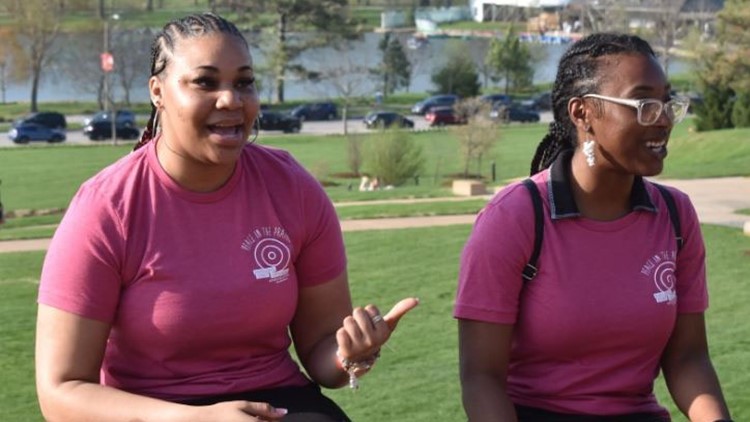ST. LOUIS — She’Kinah Taylor remembers the first time she saw the prairie. But mostly, she remembers not what she saw, but what she heard: a quiet totally unlike the noise of her St. Louis city neighborhood.
She was in her late teens the first time she went to see a prairie—Shaw Nature Reserve—though that prairie had been sitting 30 minutes outside St. Louis city her entire life.
“I stay in the city, and it’s loud,” Taylor said. “You hear horns, and everything. And I do have a lot of people in my family, and we’re all loud. So when we did go [to the prairie] just walking through it at night time, the quiet part…it was very peaceful. I was like, wow, it can be quiet like this? I like this.”
Taylor is a member of St. Louis Story Stitchers, a Black youth-led art and storytelling organization that over the past six years has been working on a project called Peace in the Prairie, in which young people reflect through song, dance, poetry and music on how a connection to the outdoors might help them—and the St. Louis community —heal from the long-term impacts of gun violence.
On Earth Day, April 22, the Story Stitchers unveiled an hour long documentary art film addressing the intersections between the violence of urban life and the violence done to the planet via extractivism and unhealthy environmental management practices. In the film, images of buffalo grazing are juxtaposed with voice-overs telling the stories of murdered family members, fights after school that nearly turned violent, and first memories of gunshots. And the Story Stitchers sing about biodiversity and building a safer St. Louis over video of their peers breakdancing amid the tall grass.
Susan Colangelo, the founder of Story Stitchers, said the seeds of Peace in the Prairie emerged from her own childhood with a family that went camping frequently. She realized the young people she worked with didn’t have that experience—and many of them didn’t even make use of the city parks near them.
According to a 2020 report from the Outdoor Foundation, Black Americans represented 12.4% of the U.S. population in 2019, but only 9.4% of outdoor activity participants. The outdoors for a child that grows up north of the Delmar divide is often what they see when they walk out of their front door; a vacant building or lot filled with building debris. With Black families forced into the most environmentally and physically unsafe neighborhoods in the city, it’s no wonder that many of the Black young people in Story Stitchers hadn’t been to the prairie before.
In the Peace in the Prairie documentary, six members of Story Stitchers spoke around a campfire about their first experiences with gun violence. Each of the six young people, in sequence, says that their first time being aware of a shooting, or witnessing one, was in kindergarten.
“It started to dawn on me, they were telling me they really only went to city parks, and were scared to go there,” Colangelo said. “What would happen if we took them into a more natural setting? So we tried it…and we saw tremendous change from the exposure to natural areas in some of the young people. Giddiness, absolute freedom.”
Rachael Jones, a poet who worked on the Peace in the Prairie project, said that it allowed the young people to get an up close and personal look at why climate change and land use matter.
“We noticed that, if that land isn’t set aside and preserved, it tends to be taken and turned into industrial property,” she said.
“So, we’re raising awareness about climate change…we want to let nature take back the land we’ve kind of taken away from her.”
Less than one half of 1% of the original tall grass prairies remain in Missouri, making them one of the most endangered habitats in the world. As the prairies shrink, the capacity to utilize them in order to work through trauma shrinks, too.
At the Earth Day film premiere event, in Forest Park, the connection between healing from gun violence and healing the prairie became explicit: groups including Moms Demand Action for Gun Sense and the Crime Victim’s Center made presentations, as did the Audubon Center—a nonprofit focused mostly on bird preservation—and the Missouri Prairie foundation.
Trayvon Rogers, a Story Stitchers Youth Council member, said that being in the prairie affected him profoundly.
“I learned about…the importance of healing, and recharging yourself. For me, healing looks like being with myself…just chilling out, and not worrying so much about what I need to do.” In the song “Prairie Therapy,” which the Story Stitchers created at Shaw Nature Reserve, they share that same sentiment: “back at home I feel the tension in the undertones, but here it’s nothing close.”
Susan Colangelo saw that change happen. “When they get there, they’re transformed. Sometimes they might not have felt that safe, ever, I think.”
The Story Stitchers: Peace in the Prairie film is available at storystitchers.org.


